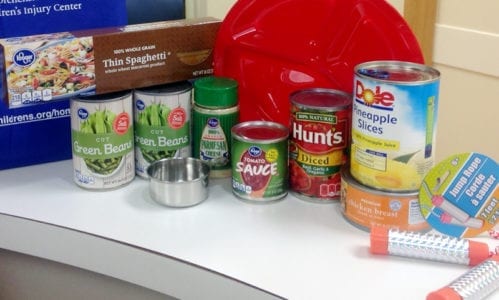Families face many challenges when working to get a healthy meal on the table. Time, energy, and expense are a few that come to mind. As a dietitian in the Center for Better Health and Nutrition, I’m always looking for new ways to help our patients and community accomplish that goal.
That’s how the idea for “Fit Kits” came to be. A local school-based clinic called our HealthWorks! program to help provide intensive nutrition and exercise counseling. 44% of its students seen in the clinic are overweight or obese, but with the student population hovering around 800, we didn’t have enough time or resources to get to every kid.
Therefore, I wondered if it would be feasible to send both edible and educational materials home with students, and eventually received a grant to make it happen. We wanted to reach the whole school and do prevention, not just kids who are already diagnosed as overweight or obese. We also wanted this approach to help the whole family, as healthy habits are typically more successful when entire families are involved. 
Dubbed “Fit Kits,” they include shelf-stable foods, recipes, a portioned plate, and a jump rope or beach ball with game ideas included. The educational materials sent home throughout the year covered topics such as tips for smart snacking; limiting sugary drinks; the importance of whole grains and fiber; samples of healthy breakfasts; tips to sleep better; limiting screen time; and exercise guidelines. Essentially, the tools to get started on the path to better health.
I thought it might be helpful to share some take-away points from the “fit kit” program that could help other families. With September being childhood obesity awareness month, I think these points are important to remember. Families are busier than ever, and meals don’t need to be expensive and labor-intensive to be healthy.
A Few Take-Aways from the Fit Kit Program
-
Utilize portioned plates
They can be very helpful for families to understand how much of what type of food they should be eating. Fruits and veggies are half of the plate. Smaller portions for meats and grains.
-
Meal planning can help
Do your grocery shopping for the entire week and plan out each night’s meal. I realize this is easier said than done, but once you’re in the routine, it will make a huge difference!
-
Shelf-stable foods can be healthy, too
Fresh, frozen and canned fruits and vegetables – drained and rinsed – are all nutrient-rich choices. An example of one of our fit kits included whole wheat pasta with tomato sauce, canned chicken, green beans and pineapple.
-
Healthy meals don’t have to be super expensive
The meal listed above costs around $9 at our local grocery, and will feed a family of four.
While our main goal was to see if this type of intervention was feasible, we do hope that it ultimately helped to change some of their behaviors. Families reported using the tangible tools provided and were very thankful for the food sent home. We will be expanding this program to other schools in the 2018-2019 school year.
If you’d like to learn more about our HealthWorks! program, please call 513-636-4305.





